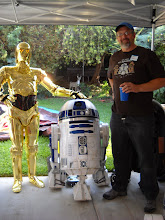


 I've been thinking about weathering for months now. Lots of R2 builders just can't bring themselves to wreck the paint job with a bunch of crud. And I can understand that. But I've always wanted him to be dirty like in A New Hope. It's just not right for R2 to be too clean. One of the interesting things that Lucas did with the first movie in the 70s was portray the droids and the technology and the exotic props as worn, used, and lived in. This in contrast to movies of the era like 2001, or Star Trek where the props and the ships are a focal point of the movie and they are put on a pedestal with the camera work and story line. Lucas wanted all the normal stuff of life to just be in the background, hence lots of cool tech and gadgets slip by in seconds on screen. Dirty droids are a central part of his vision. So R2 has to be covered in crud.
I've been thinking about weathering for months now. Lots of R2 builders just can't bring themselves to wreck the paint job with a bunch of crud. And I can understand that. But I've always wanted him to be dirty like in A New Hope. It's just not right for R2 to be too clean. One of the interesting things that Lucas did with the first movie in the 70s was portray the droids and the technology and the exotic props as worn, used, and lived in. This in contrast to movies of the era like 2001, or Star Trek where the props and the ships are a focal point of the movie and they are put on a pedestal with the camera work and story line. Lucas wanted all the normal stuff of life to just be in the background, hence lots of cool tech and gadgets slip by in seconds on screen. Dirty droids are a central part of his vision. So R2 has to be covered in crud. I got the Celebration 3 R2 Builders DVD from McMaster with the Don Bies weathering video and watched it carefully. Following Bies' advice, I got acrylics that would wash off in burnt umber, raw umber, burnt and raw sienna, and yellow ochre. Then I stippled, smeared, wiped, and scrubbed some of them--mostly the burnt sienna--all over him last night. With a damp cloth and a spray bottle, the paint comes off and you can get some nice irregular distributions and patterns. I also added some paint to the spray bottle to get it to run down the body. When the color gets down into the panels, they really stand out whereas without paint they all kind of blend in and the droid looks flat and featureless. Check it out. I started at the bottoms of the feet in the back just to get a feel for it and went slow. Then I built up my courage as I got satisfied with the look of it and moved towards the front. Important rule: When you're launching into a technique that you're new to, always start in the back or somewhere less visible.
But weathering turned out to be pretty forgiving, I think. I like the results, with an exception I'll mention below, and it was pretty easy to get a look that I liked. And as soon as some of the crud went on, you could just see the character of the droid come out. It was like it wasn't really R2 until he looked like he'd been through all kinds of rough, messy abuse.
Don Bies recommended against using any blacks for weathering. His claim was that a lot of fan stuff has black on it for weathering, but it looks too stark, or like it's trying too hard. I can understand that. So I stuck to the red and browns, and they're good. They definitely have a Tatooine look to them. But when you look at the first 20 minutes of A New Hope, there's just no mistaking the fact that R2 has a lot of greasy black smudges all over him. He's got mechanical weathering, not just dirt. So I got some black today and I'm going to layer on another course to get him darker. Another thing you can see once you watch the scenes just for the weathering is the different R2s that they used in the different scenes. That is, the weathering patterns are really different on them,and you can tell that it's a different model from scene to scene. You'd think they would have made a bigger effort at continuity. But I guess it took me almost 35 years to notice.
A lot of non-fans don't really understand why we'd want to dirty our hard work up like this, but now that I've done it, he looks a lot better.



















